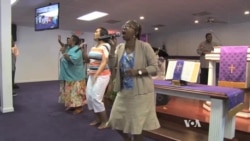Editor's note: VOA reporter Alberto Pimienta gives impressions from Ferguson, Missouri, where the main topic of conversation during recent days has been an African-American teenager, getting ready to go to college, who was killed by a white police officer.
During a scorching hot day in Ferguson, Missouri, this community tries to go back to normal after the death of Michael Brown, an unarmed African-American teenager who was shot and killed on August 9 by Darren Wilson, a white police officer.
Ferguson a town of about 21,000 residents is 67.4 percent black, according to the latest census data.
Driving on the main road of this St. Louis suburb, the first thing that grabs your attention is that some commercial establishments have wooden boards covering their windows, however, most of them are open again to the public after looting and intense street protests.
Another thing that becomes noticeable right away is how friendly people are here. Everyone seems willing to lend a hand when someone needs directions or simply when someone, from the media especially, tries to talk to them.
This is a community that is longing to share how it feels after a collective wound left behind by a death that has taken the national spotlight, and in some degree, world attention.
During these days when you hear the word Ferguson, many people think of protests and looting but at this moment here, the reality is different.
Change sought
The city, little by little, is trying to go back to normal everyday life, to how things were before August 9.
However, the majority of residents do want something to change how police treat the black population in the city.
“The situation here is dire and it became that way because the average young black male is targeted, he is a subject of ridicule, a subject of distrust and misinterpretation, the reason why this is all going on is because of how the young American black man is portrayed here in the United States,” said Mark, a resident of Ferguson, who did not want to share his last name.
While talking with many residents, a lot of them want this moment of indignation, as they called it, to also be an opportunity to unite the community and prevent such events in the future.
Brown’s killing took place near some apartment buildings. Sunday, all around the residential complex, there were people offering free food like hot dogs, chips or water.
John Bonds, who grilled the hot dogs, told VOA he hoped to use this as a way to bring together Ferguson and neighboring suburbs of St. Louis, where, according to him, several black communities recently had not gotten along.
“For whatever reasons, we did not like each other. Since this kicked off, we all came together,” Bonds said.
Officials said police officer Darren Wilson shot Brown in self defense.
The Ferguson police department also made public security camera video that appears to show Brown, the teenager, robbing a store in Ferguson minutes before his death.
Grand jury convenes
On August 20, a grand jury of nine white people and three black people convened to go over evidence presented by the St. Louis county prosecutor, to decide if there will be formal charges filed against the police officer.
A lot of people in the black community in Ferguson do not trust the local investigation. but they do trust in the federal investigation that is being conducted by the Department of Justice and the FBI.
The grand jury decision could take weeks. Until then, no one will have a complete picture of what transpired in Ferguson just before noon on August 9.
WATCH: Related video report by Chris Simkins










